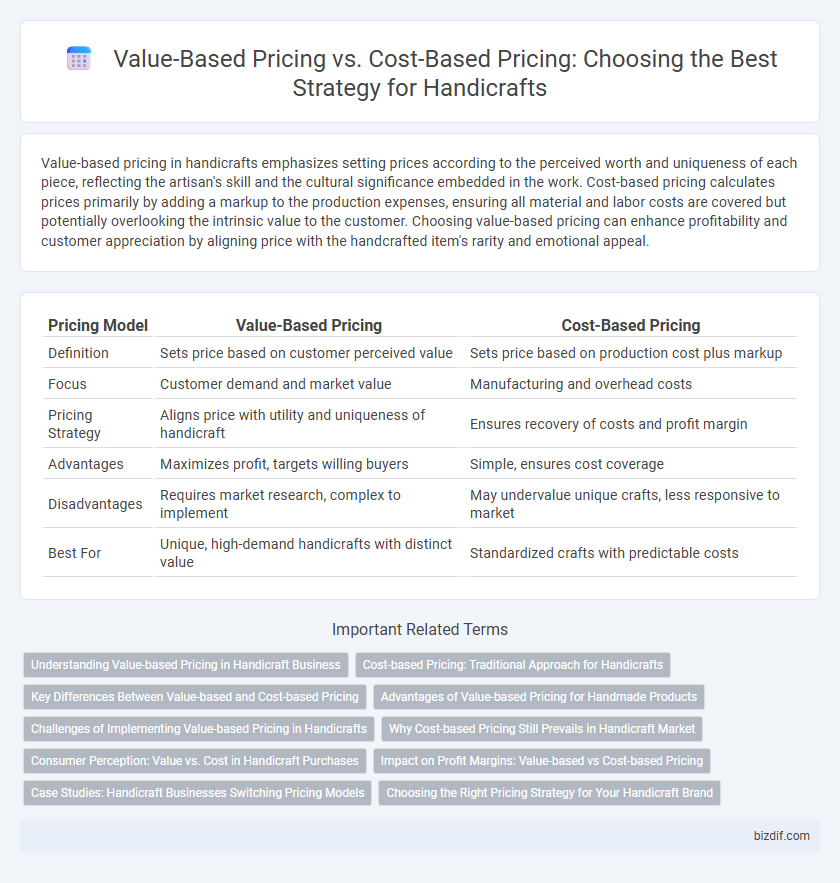Value-based pricing in handicrafts emphasizes setting prices according to the perceived worth and uniqueness of each piece, reflecting the artisan's skill and the cultural significance embedded in the work. Cost-based pricing calculates prices primarily by adding a markup to the production expenses, ensuring all material and labor costs are covered but potentially overlooking the intrinsic value to the customer. Choosing value-based pricing can enhance profitability and customer appreciation by aligning price with the handcrafted item's rarity and emotional appeal.
Table of Comparison
| Pricing Model | Value-Based Pricing | Cost-Based Pricing |
|---|---|---|
| Definition | Sets price based on customer perceived value | Sets price based on production cost plus markup |
| Focus | Customer demand and market value | Manufacturing and overhead costs |
| Pricing Strategy | Aligns price with utility and uniqueness of handicraft | Ensures recovery of costs and profit margin |
| Advantages | Maximizes profit, targets willing buyers | Simple, ensures cost coverage |
| Disadvantages | Requires market research, complex to implement | May undervalue unique crafts, less responsive to market |
| Best For | Unique, high-demand handicrafts with distinct value | Standardized crafts with predictable costs |
Understanding Value-based Pricing in Handicraft Business
Value-based pricing in the handicraft business centers on setting prices according to the perceived value of handmade products by customers rather than the production cost. This strategy emphasizes unique craftsmanship, cultural significance, and emotional connection, allowing artisans to capture a premium price reflective of the product's distinctiveness. By aligning pricing with customer perception of worth, artisans can enhance profitability and sustain their creative heritage in competitive markets.
Cost-based Pricing: Traditional Approach for Handicrafts
Cost-based pricing in handicrafts involves setting prices by calculating the total production cost, including materials, labor, and overhead, then adding a fixed profit margin. This traditional approach ensures artisans cover expenses while maintaining affordability but may undervalue unique craftsmanship and market demand. Emphasizing cost components helps artisans maintain sustainable operations but often misses opportunities for premium pricing based on artistic value or customer perception.
Key Differences Between Value-based and Cost-based Pricing
Value-based pricing sets product prices according to the perceived value to the customer, often allowing artisans to capture higher margins by emphasizing uniqueness and craftsmanship in handicraft goods. Cost-based pricing calculates prices based on production expenses plus a markup, ensuring costs are covered but potentially undervaluing the artistic and emotional appeal of handmade items. Key differences include value-based pricing focusing on customer willingness to pay and market demand, while cost-based pricing prioritizes internal cost recovery and standard profit margins.
Advantages of Value-based Pricing for Handmade Products
Value-based pricing maximizes profit by aligning prices with the perceived worth of handmade products, reflecting their uniqueness and craftsmanship. It allows artisans to capture higher margins by emphasizing quality, exclusivity, and emotional connection with customers. This strategy fosters brand loyalty and positions handmade goods as premium offerings in competitive markets.
Challenges of Implementing Value-based Pricing in Handicrafts
Implementing value-based pricing in handicrafts challenges artisans due to the difficulty in quantifying intangible cultural and emotional values that customers associate with handmade products. Market awareness and customer education are often limited, leading to undervaluation and inconsistent pricing strategies. Additionally, fluctuating material costs and time-intensive craftsmanship complicate aligning perceived value with sustainable profit margins.
Why Cost-based Pricing Still Prevails in Handicraft Market
Cost-based pricing continues to dominate the handicraft market due to its simplicity and direct alignment with production expenses such as raw materials, labor, and time investment. Artisans often lack access to comprehensive market data or advanced pricing tools, making cost-based methods more practical for ensuring minimum profitability. Moreover, the personalized and unique nature of handicrafts challenges the application of value-based pricing, as perceived customer value can be highly subjective and difficult to quantify.
Consumer Perception: Value vs. Cost in Handicraft Purchases
Value-based pricing in handicrafts emphasizes the unique artistry and emotional appeal consumers associate with handmade items, leading to higher willingness to pay despite higher costs. Cost-based pricing focuses on covering production expenses, often overlooking the perceived cultural and aesthetic value that drives consumer demand. Understanding consumer perception of value over cost is crucial for artisans to price products competitively while highlighting craftsmanship and authenticity.
Impact on Profit Margins: Value-based vs Cost-based Pricing
Value-based pricing maximizes profit margins by setting prices according to the perceived value and demand of handicraft products, enabling artisans to capture consumer willingness to pay more for uniqueness and quality. Cost-based pricing, grounded in production and material expenses, often results in lower profit margins as prices reflect costs plus a fixed markup, potentially undervaluing handcrafted items' market appeal. Implementing value-based pricing enhances profitability by aligning prices with customer value perception, whereas cost-based pricing may limit earnings despite controlling costs.
Case Studies: Handicraft Businesses Switching Pricing Models
Handicraft businesses shifting from cost-based to value-based pricing often experience increased revenue by aligning prices with customer perceived value rather than production costs. Case studies reveal that artisans adopting value-based pricing leverage unique craftsmanship and cultural storytelling to justify premium prices, enhancing brand loyalty and market differentiation. Data from these businesses show improved profit margins and sustainable growth compared to traditional cost-plus pricing methods.
Choosing the Right Pricing Strategy for Your Handicraft Brand
Value-based pricing maximizes profits by setting prices based on customers' perceived worth of unique handicrafts, enhancing brand differentiation and customer loyalty. Cost-based pricing ensures all production expenses and labor are covered but may undervalue the artistic and cultural significance embedded in handmade products. Handicraft brands benefit most from value-based pricing to reflect craftsmanship quality, cultural heritage, and exclusivity, attracting discerning buyers willing to pay premium prices.
Value-based Pricing vs Cost-based Pricing Infographic

 bizdif.com
bizdif.com